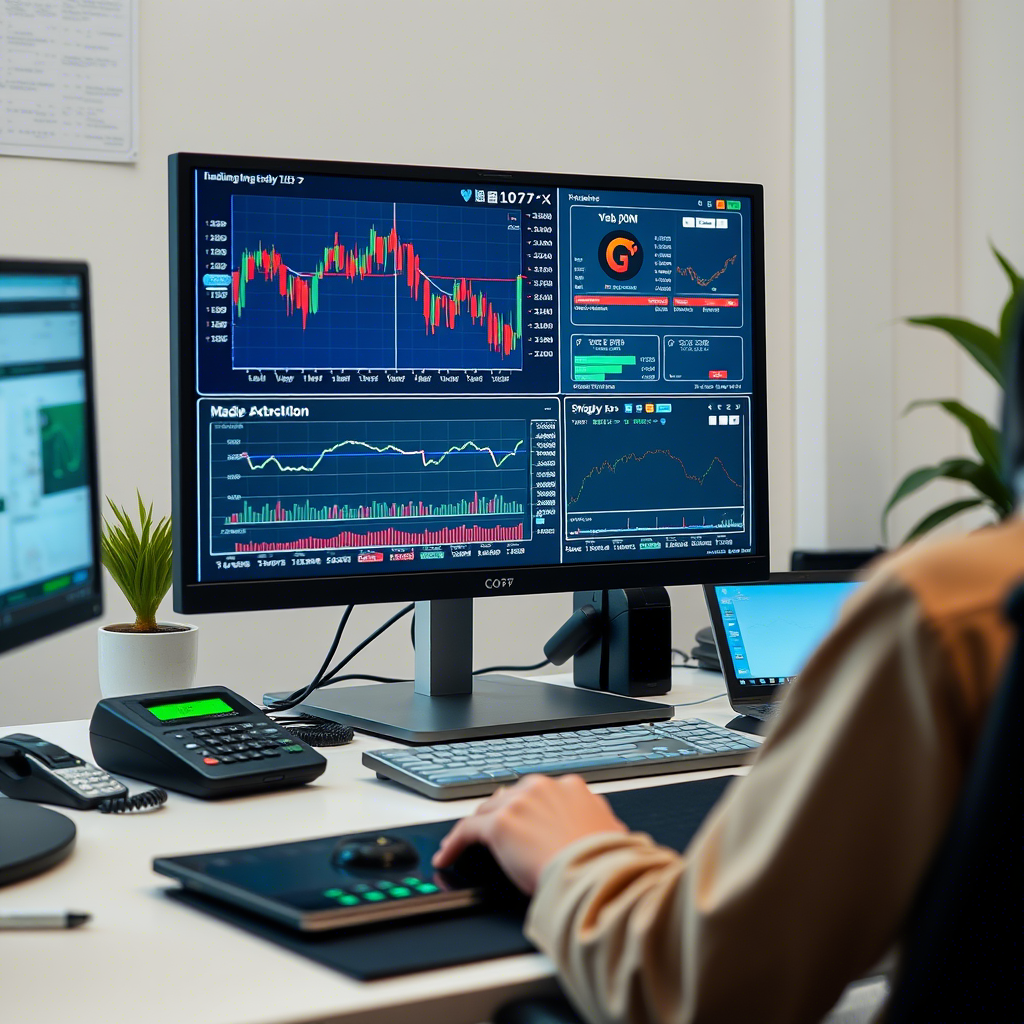Currency Day Trading: Your Guide to Profiting in the Forex Market

Currency Day Trading: Your Guide to Profiting in the Forex Market
Introduction to Currency Day Trading
Currency day trading involves buying and selling currency pairs within a single trading day to profit from short-term price movements in the forex market, the world’s largest and most liquid financial market. With trillions traded daily, forex offers high liquidity and volatility, ideal for day trading. This guide provides beginners with a comprehensive roadmap to succeed in currency day trading, covering strategies, risk management, and practical steps.
What is Day Trading in Forex?
Day trading means opening and closing trades within the same day, avoiding overnight positions. Traders capitalize on small price fluctuations, often using leverage to amplify returns. The forex market’s 24/5 operation across global hubs like London, New York, and Tokyo makes it perfect for day trading due to constant price action and high liquidity.
Key Concepts for Day Trading
- Currency Pairs: Traded in pairs (e.g., EUR/USD). Major pairs (e.g., USD/JPY, GBP/USD) are preferred for tight spreads and high liquidity.
- Pip: The smallest price movement, typically the fourth decimal place (e.g., 1.3050 to 1.3051 is one pip).
- Spread: The difference between bid (sell) and ask (buy) prices, representing the broker’s fee. Lower spreads are critical for day trading.
- Leverage: Allows control of larger positions with less capital (e.g., 50:1 leverage means $1,000 controls $50,000), but increases risk.
- Volatility: Rapid price changes driven by news, economic data, or market hours, creating day trading opportunities.
- Market Sessions: Peak liquidity occurs during London-New York overlaps (8 AM–12 PM EST), ideal for day trading.
Effective Day Trading Strategies
- Scalping:
- Concept: Take multiple small trades (5-10 pips) throughout the day, holding positions for minutes.
- Tools: 1-minute or 5-minute charts, RSI, Bollinger Bands. Enter when RSI signals overbought/oversold.
- Best for: High-liquidity pairs like EUR/USD during active sessions.
- Example: Buy EUR/USD on a 5-minute chart when RSI dips below 30, with a 5-pip target and 3-pip stop-loss.
- Breakout Trading:
- Concept: Trade when prices break through support or resistance, indicating a potential trend.
- Tools: 15-minute charts, candlestick patterns (e.g., bullish engulfing), volume indicators.
- Best for: London session openings or after economic news.
- Example: Buy USD/JPY if it breaks above 150.00 with high volume, setting a 10-pip target and 5-pip stop-loss.
- Range Trading:
- Concept: Buy at support and sell at resistance in sideways markets.
- Tools: 15-minute charts, support/resistance levels, Stochastic Oscillator.
- Best for: Low-volatility periods (e.g., Asian session for EUR/USD).
- Example: Sell GBP/USD at resistance (1.4000) if Stochastic shows overbought, targeting 8 pips with a 4-pip stop-loss.
- News-Based Trading:
- Concept: Trade volatility from economic releases (e.g., non-farm payrolls, interest rate decisions).
- Tools: Economic calendars, 5-minute charts, fundamental analysis.
- Best for: Experienced day traders comfortable with volatility.
- Example: Buy USD/CAD after a surprise U.S. rate hike, targeting 15 pips with a 7-pip stop-loss.
Risk Management for Day Trading
Day trading’s fast pace demands strict risk management to protect capital:
- Risk 1-2% Per Trade: Limit losses to 1-2% of your account (e.g., $10-$20 on a $1,000 account).
- Stop-Loss Orders: Set tight stops (3-10 pips) to cap losses, placed below support (for buys) or above resistance (for sells).
- Risk-Reward Ratio: Aim for at least 1:2 (risk $5 to gain $10) to ensure profitable trades outweigh losses.
- Low Leverage: Use 5:1 or 10:1 leverage to reduce risk in volatile conditions.
- Limit Trades: Cap daily trades at 3-5 to avoid overtrading and fatigue.
- Avoid High-Impact News: Skip trading during major releases unless using a news-based strategy.
Steps to Start Day Trading
- Learn Forex Basics: Understand pairs, pips, leverage, and market hours.
- Choose a Regulated Broker: Select a broker with low spreads (1-2 pips on EUR/USD), fast execution, and platforms like MetaTrader 4/5.
- Open a Demo Account: Practice strategies for 3-6 months to master timing and risk management.
- Build a Trading Plan:
- Choose 1-2 strategies (e.g., scalping, breakout).
- Define entry/exit rules, risk per trade, and session focus (e.g., London-New York overlap).
- Set daily loss limits (e.g., 5% of account).
- Analyze Markets:
- Use technical analysis (RSI, moving averages) for trade signals.
- Check economic calendars to avoid or target news events.
- Start Small: Trade micro lots (1,000 units) in a live account with $100-$500.
- Review Daily: Analyze trades to refine strategies and improve discipline.
Tools for Day Trading
- Trading Platforms: MetaTrader 4/5 for real-time charting, indicators, and automated orders.
- Economic Calendars: Track high-impact events to plan or avoid trades.
- Indicators: Use RSI, Bollinger Bands, or MACD for quick signal confirmation.
- Mobile Apps: Monitor trades on the go with broker-provided apps.
- Position Sizing Calculators: Ensure consistent risk based on stop-loss distance and account size.
Tips for Beginners
- Focus on Major Pairs: Trade EUR/USD or USD/JPY for tight spreads and high liquidity.
- Trade Peak Hours: Target 8 AM–12 PM EST for optimal liquidity and volatility.
- Master One Strategy: Perfect scalping or breakout trading before diversifying.
- Keep a Trading Journal: Log trades, including entry/exit, strategy, and outcomes, to track progress.
- Stay Disciplined: Follow your plan to avoid impulsive trades during fast markets.
- Practice Patience: Wait for high-probability setups rather than forcing trades.
Common Pitfalls to Avoid
- Overtrading: Taking too many trades increases fees and losses.
- Ignoring Stop-Losses: Trading without stops risks unlimited losses in volatile markets.
- High Leverage: Using 50:1 or higher leverage can wipe out accounts during sudden moves.
- Chasing Losses: Increasing trade size to recover losses often deepens drawdowns.
- Trading Without a Plan: Random trades without strategy lead to inconsistent results.
- News Overload: Trading every news event without preparation risks slippage and losses.
Psychological Discipline
Day trading demands intense focus and emotional control. Fear can lead to early exits, while greed may prompt overtrading or ignoring stops. Develop a routine, such as reviewing your plan before sessions, and take breaks to avoid burnout. Sticking to risk rules and high-probability setups builds confidence and reduces emotional errors.
Building Long-Term Success
Profiting from day trading requires mastering strategies, managing risks, and maintaining discipline. Start with simple approaches like scalping or range trading, backtest them, and refine based on results. Trade during high-liquidity sessions and focus on major pairs to minimize costs. With consistent practice and risk control, day trading can become a viable path to forex profits.
Practical Steps to Begin
- Study Day Trading: Learn scalping, breakout, and range trading through tutorials or books.
- Set Up a Platform: Use MetaTrader 4/5 with indicators like RSI and moving averages.
- Practice in a Demo Account: Trade for 3-6 months, focusing on 1-2 strategies during peak hours.
- Trade Major Pairs: Start with EUR/USD or USD/JPY for low spreads and high volume.
- Start Small: Open a live account with $100-$500 and trade micro lots.
- Review Daily: Analyze trades to improve strategy execution and risk management.
Conclusion
Currency day trading offers exciting opportunities to profit from short-term price movements in the forex market. By mastering strategies like scalping, breakout, or news trading, and prioritizing risk management, beginners can navigate the market effectively. Start with a demo account, focus on major pairs, and trade during high-liquidity sessions to optimize results. With discipline, continuous learning, and emotional control, you can build a successful day trading approach and achieve consistent profits in forex.




